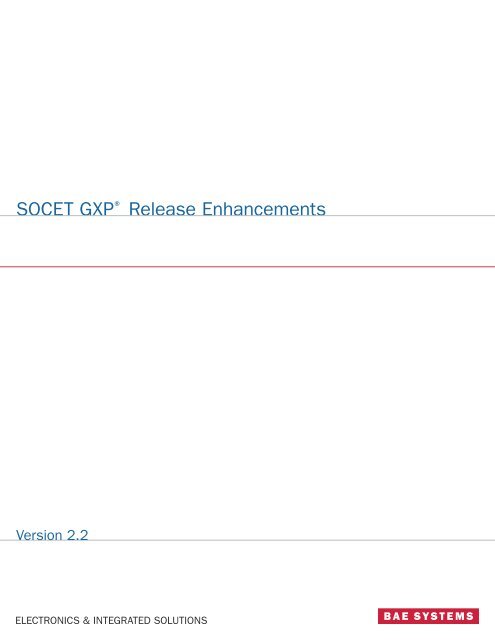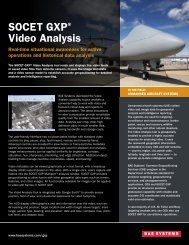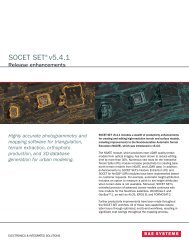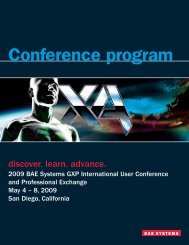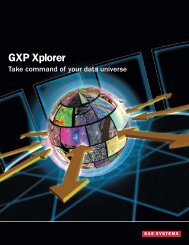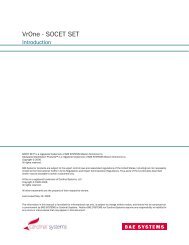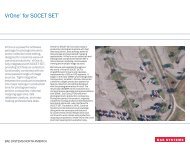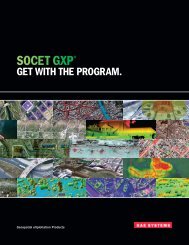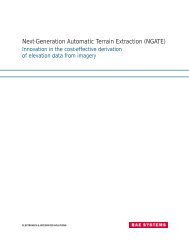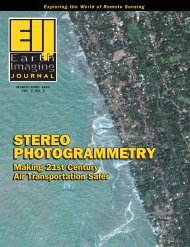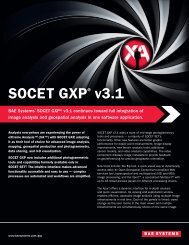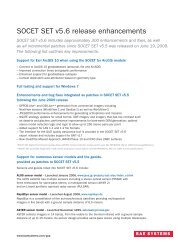SOCET GXP 2.2 Release Enhancements2.indd - BAE Systems GXP ...
SOCET GXP 2.2 Release Enhancements2.indd - BAE Systems GXP ...
SOCET GXP 2.2 Release Enhancements2.indd - BAE Systems GXP ...
You also want an ePaper? Increase the reach of your titles
YUMPU automatically turns print PDFs into web optimized ePapers that Google loves.
<strong>SOCET</strong> <strong>GXP</strong> ® <strong>Release</strong> EnhancementsVersion <strong>2.2</strong>ELECTRONICS & INTEGRATED SOLUTIONS
Users may point <strong>SOCET</strong> <strong>GXP</strong> to an Auto DTED directory so that images and terrain data needed for flythrough and other terrain related tools canbe accessed automatically; HRTI and SRTM terrain support is included Option to save a flythrough as a graphic or record an .avi file to include in finished productsTerrain analysisTerrain analysis is the first step towards full terrain modeling and editing, which will be a feature of the next generation of <strong>SOCET</strong> <strong>GXP</strong>. Users now havethe capability to include terrain data in image analysis. The new Line of Sight tool analyzes terrain either by default or by user-defined parameters; analysts can use a predetermined boundary, or enter acustom height by placing a marker on the image and letting <strong>SOCET</strong> <strong>GXP</strong> color the visible areas across the entire image—clicking on other areas ofthe image updates the image automatically The Terrain Visualization toolbar allows users to auto load terrain, draw the terrain graphically via contours, dots, or mesh, create TSRs, andaccess the terrain properties to edit terrain visualization attributes Terrain profiling allows for detailed elevation analysis along a specific line; the result is displayed in a graph where users may click along any pointand see where that point lies in the image; the graph may be saved as a picture, or a snapshot of the result can be used in a finished product Terrain tracking gives users the capability to view elevation data continuously using the location of the mouse; the tool uses elevation data, whichis loaded automatically with the image via the Auto DTED preference file; elevations are displayed at the bottom of the MultiportAuto<strong>SOCET</strong>Auto<strong>SOCET</strong> gives users with little or no photogrammetry experience the tools to perform triangulation automatically and to create terrain files,orthophotos and orthomosaics. Access to this functionality is available through VCT or directly from the Workspace Manager. Auto<strong>SOCET</strong> windowsare easy to use and increase efficiency, allowing users to select jobs and options associated with a particular job. In future versions, users will be ableto select areas of interest across data sets and launch photogrammetric processes directly from imagery. Select files from data view and launch the new Auto<strong>SOCET</strong> window using the right mouse button Users may enter the location of the DTED file needed for triangulation or have Auto<strong>SOCET</strong> create its own elevation fileComparisonAnalyzing and comparing images is vital to the image analysis workflow. <strong>SOCET</strong> <strong>GXP</strong> v<strong>2.2</strong> increases the capability to recognize and identify changes. The Multi-Color comparison views option allows users to analyze more than two layers in a panel With the click of a button, users can automatically link panels that exist within the same Mulitport; the link properties are driven via preferencesand users may choose to link images by zoom, roam, graphics or cursor The porthole tool has been enhanced to include a swiper mode; this allows users to put images together within one panel and “swipe” across theimages to see changes; the porthole tool also allows users to define up to four Autolabels to update dynamically while paging through layers withina panel Users may now annotate per image via the Graphics Manager; one click puts users in a mode that allows them to annotate items of interest on theground on a per-image basis Autolabels have been enhanced to update values dynamically according to which image is on top; users now receive vital information during flickermode based on which image is being viewedProduct creation<strong>SOCET</strong> <strong>GXP</strong> offers the most efficient tools in the industry for creating and distributing finished products. The product creation toolset offersenhancements that give users the capability to deliver accurate information to decision makers quickly and easily. New drawer added to the Graphics Manager for the Directional Arrow; used on an image to display rotation values graphically within the imagemetadata Rotation values have been added to the Autolabel drawer to display the text value with the Directional Arrow The Other Image Metadata button gives users access to the image metadata of the primary image; when the user selects a tag from the windowand clicks on the image, the value of that tag appears; any tag may be selected from the metadata to use on a template during analysis orproduct creation Edit or create new templates directly from the Multiport without having to be in Create Template modePlatforms and sensors<strong>SOCET</strong> <strong>GXP</strong> v<strong>2.2</strong> supports new sensors and image formats, and includes mathematical models for the sensors listed below. These models areessential for accurate geolocation and measurement as well as fatigue-free stereoscopic viewing.– IKONOS®-2 - Panchromatic (Pan), MSS, Pan/MSS blend– IRS-1C – LISS III, Pan– IRS-1D – LISS III, Pan– QuickBird – Pan, MSS– SPOT 5 – HRG– Landsat 3 & 4 – MSS– Landsat 7 – ETM+– U2 – SYERS-2 Pan, ASARS-2, ASARS-2a– F-14 – TARPS-CD EO Frame– F/A-18D – ATARS MAEO, LAEO– F/A-18E/F – SHARP EO/IR Frame
– Global Hawk UAV – EO, IR, SAR– Predator UAV – EO, IR– Space Shuttle Endeavour – C-band radar– NTMData formats<strong>SOCET</strong> <strong>GXP</strong> v<strong>2.2</strong> can read and write data in the formats listed below. Additional formats are added often, in response to customer requests.– NITF 2.1, NITF 2.0, NITF CGM (JITC certification in progress)– Multi Image NITF support for saving virtual mosaics– NITF MITOCA TRE data ingest– JP02 IOC1 and IOC2– NSIF (NATO Secondary Image Format) 1.0– ESRI shapefiles– GeoTIFF 6.0 w/ArcWorld (*.tfw) file– VITec image (.vit) and annotation(.anno) files– JPEG– JPEG 2000– Gridlock Smart Images– Sun Raster– TFRD 1.3, 2.3, 4.3– CompuServe GIF– Windows bitmap (bmp)– Tactical Image ID– Tactical Sensors (Global Hawk, Predator, ASARS-2, ASARS-2a, SYERS, ATARS, SHARP, TARPS CD)– CADRG– ADRG– Controlled Image Base (CIB®)– ASRP–SRTM DTED level 2–HRTI– IKONOS– QuickBird– Landsat 7 ETM+ sensor in GeoTIFF, NDF, Fast L7, Fast L7a and ACRES– Landsat 3 & 4 NLAPS– SPOT CAP and SPOT 5 DIMAP– IRS LISS Super Structure format in BSQFor more information, please contact your local <strong>GXP</strong> Distributor or the <strong>BAE</strong> <strong>Systems</strong> sales office nearest you:AmericasTelephone (800) 316-9643 or (703) 668-4385 Fax (703) 668-4381Email socetgxp.sales@baesystems.comEurope, Middle East and Africa (EMEA)Telephone +44 0 1223 370023 Fax +44 0 1223 370040Email socetgxp.emea.sales@baesystems.comAsia- PacificTelephone +61 2 6273 0111 Fax +61 2 6273 0368Email socetgxp.asia.sales@baesystems.comwww.baesystems.com/gxpEXPORT CONTROLLED DATA. These commodities, technology or software are controlled for export in accordance with the U.S. Export Laws. Diversion contrary to U.S. Law isprohibited. <strong>Release</strong> is approved as of May 11, 2006 to all parties cleared against the Denied Party Screening.S<strong>GXP</strong>RE<strong>2.2</strong> 05/06


